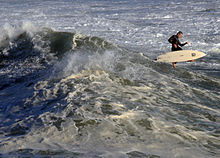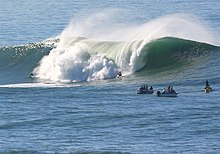Two major subdivisions within stand-up surfing are longboarding and shortboarding, reflecting differences in surfboard design including surfboard length, and riding style.
In tow-in surfing (most often, but not exclusively, associated with big wave surfing), a motorized water vehicle, such as a personal watercraft tows the surfer into the wave front, helping the surfer match a large wave's higher speed, a speed that is generally, but not exclusively a speed that a self-propelled surfer can not match.
Surfing-related sports such as paddleboarding and sea kayaking do not require waves, and other derivative sports such as kitesurfing and windsurfing rely primarily on wind for power, yet all of these platforms may also be used to ride waves.
Recently with the use of V-drive boats, wake surfing, riding the boat wake has emerged.
Surf waves
See also: Ocean surface wave

A surfer at Santa Cruz, California

A surfer in Santa Cruz, California
Local wind conditions affect wave quality, since the surface of a wave can become choppy in blustery conditions. Ideal conditions include a light to moderate "offshore" wind, because it blows into the front of the wave, making it a "barrel" or "tube" wave.
The most important influence on wave shape is the topography of the seabed directly behind and immediately beneath the breaking wave. The contours of the reef or bar front becomes stretched by diffraction. Each break is different, since the underwater topography of one place is unlike any other. At beach breaks, sandbanks change shape from week to week. Surf forecasting is aided by advances in information technology. Mathematical modeling graphically depicts the size and direction of swells around the globe.
Swell regularity varies across the globe and throughout the year. During winter, heavy swells are generated in the mid-latitudes, when the north and south polar fronts shift toward the Equator. The predominantly westerly winds generate swells that advance eastward, so waves tend to be largest on west coasts during winter months. However, an endless train of mid-latitude cyclones cause the isobars to become undulated, redirecting swells at regular intervals toward the tropics.
East coasts also receive heavy winter swells when low-pressure cells form in the sub-tropics, where slow moving highs inhibits their movement. These lows produce a shorter fetch than polar fronts, however they can still generate heavy swells, since their slower movement increases the duration of a particular wind direction. The variables of fetch and duration both influence how long wind acts over a wave as it travels, since a wave reaching the end of a fetch behaves as if the wind died.
During summer, heavy swells are generated when cyclones form in the tropics. Tropical cyclones form over warm seas, so their occurrence is influenced by El Niño & La Niña cycles. Their movements are unpredictable. They can move westward as in 1979, when Tropical Cyclone Kerry wandered for three weeks across the Coral Sea and into Queensland before dissipating.
Surf travel and some surf camps offer surfers access to remote, tropical locations, where tradewinds ensure offshore conditions. Since winter swells are generated by mid-latitude cyclones, their regularity coincides with the passage of these lows. Swells arrive in pulses, each lasting for a couple of days, with a few days between each swell.




Tidak ada komentar:
Posting Komentar